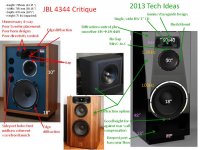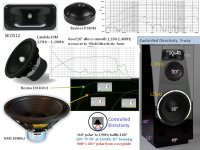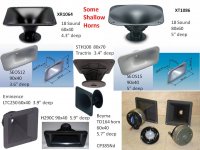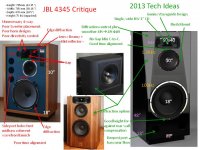I have been interested in making some JBL 4343/4344 type of clones but I want to use new drivers and do things a bit differently with it. The JBLs are kinda like a template of what I want to do.
So far I know I want to use the following.
BMS Coaxial CD w/ 10" diameter OS horn
10" Mid driver(undecided)
18" BMS 18N862 for bass driver.
due to the coaxial CD you can still call this a 4 way design, just like the JBL 43xx I mentioned above.
Can anyone suggest a good 10" mid? I was thinking of some B&C or Precision Devices but I am not too sure. I have also heard that PHL drivers are pretty good but I dont know much about them.
The the other thing I was curious about was this slightly different approach that I am interested in taking.
What if I install a Low pass filter before the amps and route that to a DSP amp for the 18N862? This would allow me to build a simpler passive crossover as well as have better control of how the bass interact with my room and with other subs in the room to help fix any nulls.
Anyone know if that is a good idea at all?
Any input would be great!
Thanks
So far I know I want to use the following.
BMS Coaxial CD w/ 10" diameter OS horn
10" Mid driver(undecided)
18" BMS 18N862 for bass driver.
due to the coaxial CD you can still call this a 4 way design, just like the JBL 43xx I mentioned above.
Can anyone suggest a good 10" mid? I was thinking of some B&C or Precision Devices but I am not too sure. I have also heard that PHL drivers are pretty good but I dont know much about them.
The the other thing I was curious about was this slightly different approach that I am interested in taking.
What if I install a Low pass filter before the amps and route that to a DSP amp for the 18N862? This would allow me to build a simpler passive crossover as well as have better control of how the bass interact with my room and with other subs in the room to help fix any nulls.
Anyone know if that is a good idea at all?
Any input would be great!
Thanks
A 2013 critique of the 1970's 4344 offers a few areas for improvement:
1) Edge diffraction.
2) Unnecessary 4-way.
3) Poor tweeter placement.
4) Poor horn designs.
5) Poor directivity control (tweeter lobing)
6) Gaps between the compression drivers and the midbass increases lobing.
7) Woofer ports next to midbass hurts coherent wavefront launch
8) Midrange Xover freq is in middle of speaking voice range.
The EconoWave group research has done a very good job evaluating the best 10" and 12" midbass speakers. Surprise! Surprise! The Acoustic Elegance Lambda TD10M and TD12M have the lowest measured THD. The Beyma CP380M 1" compression driver has the lowest measured THD in $100 - $200 range. Plastic diaphragms offer smooth, extended frequency performance. Econowave genius use LR4 slope since shallow SEOS physical time alignment is very close to midbass. JMLC mixed slope Xovers are worth study(Lynn Olson thread).
The midbass must be in a sealed box with absorption board like Owens 705 on 3-sides.
There are a few options for the 18" woofer.
1) BEST. Sealed with a separate amp providing Xover plus room equalization. BMS 18N862 is great!
2) Ported with Qts=0.7 for simple single amplifier option.
The BMS 18N862 performs well in an 8cuft box, with 93db/watt efficiency. Sets the speaker SPL/watt.
The Beyma 18XL60v1 performs well in a 12cuft box, with 96db/watt efficiency.
1) Edge diffraction.
2) Unnecessary 4-way.
3) Poor tweeter placement.
4) Poor horn designs.
5) Poor directivity control (tweeter lobing)
6) Gaps between the compression drivers and the midbass increases lobing.
7) Woofer ports next to midbass hurts coherent wavefront launch
8) Midrange Xover freq is in middle of speaking voice range.
The EconoWave group research has done a very good job evaluating the best 10" and 12" midbass speakers. Surprise! Surprise! The Acoustic Elegance Lambda TD10M and TD12M have the lowest measured THD. The Beyma CP380M 1" compression driver has the lowest measured THD in $100 - $200 range. Plastic diaphragms offer smooth, extended frequency performance. Econowave genius use LR4 slope since shallow SEOS physical time alignment is very close to midbass. JMLC mixed slope Xovers are worth study(Lynn Olson thread).
The midbass must be in a sealed box with absorption board like Owens 705 on 3-sides.
There are a few options for the 18" woofer.
1) BEST. Sealed with a separate amp providing Xover plus room equalization. BMS 18N862 is great!
2) Ported with Qts=0.7 for simple single amplifier option.
The BMS 18N862 performs well in an 8cuft box, with 93db/watt efficiency. Sets the speaker SPL/watt.
The Beyma 18XL60v1 performs well in a 12cuft box, with 96db/watt efficiency.
Attachments
I find acoustic lenses fascinating. Too bad they are rare to obtain from anywhere. Does anyone know where to get lenses ?
You have to agree modern speakers dont look as appealing as the vintage ones 😛
.
You have to agree modern speakers dont look as appealing as the vintage ones 😛
.
Nice Project,I think that could be a great Speaker. One thing in front; the 4 Way with the 18" JBL-2245 was the 4345!
I agree to the BMS 18N862, in my opinion one af the best 18 inch drivers that are availible on the market at the moment. I would go for a 250 L BR enclosure with a tuning to 28.5 Hz.
The lower Midrange is surely a point to discuss, what about a AE-TD10M for example?
When you choose a BMS Coaxial for the upper Mid and the Highs then I would suggest the 4595 ND thats performs great. The classical solution like JBL, separate Mid and High is also possible, a Radian with Trueextrent Diaphragm on a nice small wooden RadialHorn and from 10 or 12 kHz upward maybe a T500 of Fostex or a TAD ET703.
There are a lot of possible solutions, but when you are willing to spend some money on that project then I would go for some real good drivers!
@ Elias, Sometimes you get the old JBL lenses or copys from Kenrick Sound in Japan!
www.jbl43.com
I agree to the BMS 18N862, in my opinion one af the best 18 inch drivers that are availible on the market at the moment. I would go for a 250 L BR enclosure with a tuning to 28.5 Hz.
The lower Midrange is surely a point to discuss, what about a AE-TD10M for example?
When you choose a BMS Coaxial for the upper Mid and the Highs then I would suggest the 4595 ND thats performs great. The classical solution like JBL, separate Mid and High is also possible, a Radian with Trueextrent Diaphragm on a nice small wooden RadialHorn and from 10 or 12 kHz upward maybe a T500 of Fostex or a TAD ET703.
There are a lot of possible solutions, but when you are willing to spend some money on that project then I would go for some real good drivers!
@ Elias, Sometimes you get the old JBL lenses or copys from Kenrick Sound in Japan!
www.jbl43.com
LineSource,
Thank you for the pictures. You are pretty close to what I am going for actually. I was thinking about that AE TD10M but I have read that there can be some pretty significant variances in driver quality from AE. Have I been mislead in this area?
The Beyma looks like a great option as well. However I wonder how it measures. One thing that sold me on the BMS is the great distortion measurements that you can see here:
Data-Bass
I will not port it by the midbass for the reasons stated and the 10" midbass was planned to be sealed and I was actually thinking of something like PVC but capped and stuffed.
Elias, I dont plan on using a horn lens at all but I just saw some remakes on ebay from Kenrick sound for a pretty decent price if you are interested. I think they will come up if you just search for JBL 4343.
SpeakerFrank, One reason I wasnt looking at using a super tweeter like the TAD ET703 is because they have such narrow dispersion. This design is something that I have been learning more about and working towards for a while now and it will be used for both music and movies.
Part of the reason for going this direction too is because I can then build a small 10" midbass with horn for a center channel to put in an entertainment center or something of the sort.
One of the main goals too is to have better directivity control. the SEOS horns i have been looking at. The other horn is by Wayne Parham that I am considering.
The only thing that I may possibly sacrafice is the edge diffraction to keep a retro look but I would like to take that into account in the box design. That part is entirely reliant on the spouse as I am not allowed such decisions.
Thank you for the pictures. You are pretty close to what I am going for actually. I was thinking about that AE TD10M but I have read that there can be some pretty significant variances in driver quality from AE. Have I been mislead in this area?
The Beyma looks like a great option as well. However I wonder how it measures. One thing that sold me on the BMS is the great distortion measurements that you can see here:
Data-Bass
I will not port it by the midbass for the reasons stated and the 10" midbass was planned to be sealed and I was actually thinking of something like PVC but capped and stuffed.
Elias, I dont plan on using a horn lens at all but I just saw some remakes on ebay from Kenrick sound for a pretty decent price if you are interested. I think they will come up if you just search for JBL 4343.
SpeakerFrank, One reason I wasnt looking at using a super tweeter like the TAD ET703 is because they have such narrow dispersion. This design is something that I have been learning more about and working towards for a while now and it will be used for both music and movies.
Part of the reason for going this direction too is because I can then build a small 10" midbass with horn for a center channel to put in an entertainment center or something of the sort.
One of the main goals too is to have better directivity control. the SEOS horns i have been looking at. The other horn is by Wayne Parham that I am considering.
The only thing that I may possibly sacrafice is the edge diffraction to keep a retro look but I would like to take that into account in the box design. That part is entirely reliant on the spouse as I am not allowed such decisions.
I would understand such appreciation for a fostex, or a JBL 2402, or even a JBL 2405 (on the vertical plan), but the TAD ET703 is one of the rare supertweeters (with th JBL 2403) that do have a wide and coherent directivity behavior both horizontally and vertically.One reason I wasnt looking at using a super tweeter like the TAD ET703 is because they have such narrow dispersion.
Interesting, I'll have to look into it further then. I wonder if it would yield a significant improvment over the coaxial BMS CD?
P.s. pos...i was in Paris a few months ago. Lovely city, I will certainly be going again in the future.
P.s. pos...i was in Paris a few months ago. Lovely city, I will certainly be going again in the future.
Crossing over from a 10", seems a coaxial BMS CD is overkill (unless you want the midrange SPL of an entire horn section pointed at you at one meter 🙂) , and complicates the design with another crossover point.Interesting, I'll have to look into it further then. I wonder if it would yield a significant improvment over the coaxial BMS CD?
The annular ring diaphragms used in both the BMS 2" exit coax, and their 1" exit drivers, and the JBL and TAD tweeters all have extended range.
What dispersion pattern would you prefer in the range above the 10"?
I see. I was thinking the coaxial would be good for the top end more so than the others. Especially because I wanted to avoid any breakups as it reaches higher.
However a 1" is much more of an economical choice considering the 10" will be able to reach 1.2khz before going to the CD.
If I go with the SEOS or Wayne Parhams horn I will be obviously going with something close to 90* by 40*. Howevever I am also curious about taking an approach similar to Dr. Geddes and go with a 10" diameter oblate spheroid to match the 10" midbass.
However a 1" is much more of an economical choice considering the 10" will be able to reach 1.2khz before going to the CD.
If I go with the SEOS or Wayne Parhams horn I will be obviously going with something close to 90* by 40*. Howevever I am also curious about taking an approach similar to Dr. Geddes and go with a 10" diameter oblate spheroid to match the 10" midbass.
The only advantage the I see the BMS coax offers is more output at a lower crossover point, with extended upper response from a single point source.I see. I was thinking the coaxial would be good for the top end more so than the others. Especially because I wanted to avoid any breakups as it reaches higher.
However a 1" is much more of an economical choice considering the 10" will be able to reach 1.2khz before going to the CD.
If I go with the SEOS or Wayne Parhams horn I will be obviously going with something close to 90* by 40*. Howevever I am also curious about taking an approach similar to Dr. Geddes and go with a 10" diameter oblate spheroid to match the 10" midbass.
The 1" will easily out run a 10" in the 1200 Hz range.
You could eliminate the 10" using the coax, but that does not fit with your plan.
Using 10", you can make three identical top cabinets and put subs wherever they work best.
The BMS coax seems no smoother in the top end than the 1", they both use the same diaphragm diameter. The HF peak in the 4550 is at 18 kHz, and can be easily flattened with EQ, though it is 2000 Hz above what I can hear...
There are compelling arguments for 90 x 40 and symmetrical OS, though the shorter vertical height would tend to tip me towards 90 x 40 because the acoustic center of the center speaker would be closer to the TV screen.
Attachments
If I wasnt trying to have a system that would also allow me a moderate sized center then I would actually go for the option of a much bigger horn and do a big 2-way. Maybe the BMS 4592 with Iwata 300 horn and the BMS 18N862 or something similar.
(I would be lying if I said I still wasnt tempted to go that route)
However my system is used for both music and movies as I dont have the real estate, nor do I want the real estate to have two seperate systems.
So I want the center and mains to match very closely. Hence the use of the 10" and horn.
I Would agree with you about the center-center spacing that the SEOS horns give you as well. There is no denying that that should also yield superior imaging.
Would using a super tweeter really give me enough benefit to really take into consideration?
It really doesnt appear to be like that to me...
ALso, one of the main reasons I wanted to do this type of design is it would allow me to have a really large BR enclosure for that 18" driver and I can have a pretty good and low tuning. Then I can use some seperate subs throughout the room to fight with the nulls a bit more.
(I would be lying if I said I still wasnt tempted to go that route)
However my system is used for both music and movies as I dont have the real estate, nor do I want the real estate to have two seperate systems.
So I want the center and mains to match very closely. Hence the use of the 10" and horn.
I Would agree with you about the center-center spacing that the SEOS horns give you as well. There is no denying that that should also yield superior imaging.
Would using a super tweeter really give me enough benefit to really take into consideration?
It really doesnt appear to be like that to me...
ALso, one of the main reasons I wanted to do this type of design is it would allow me to have a really large BR enclosure for that 18" driver and I can have a pretty good and low tuning. Then I can use some seperate subs throughout the room to fight with the nulls a bit more.
The physical time alignment between the tweeter(CD) and midbass is very important if you want to use a passive crossover. Today we have very clever short SEOS waveguides that can deliver a 90H x 40V polar response that is considered ideal for home theaters. Running a square wave to each driver and recording the delay is more accurate than physcal measurement. A mic and some free software. A modest baffle slant can time align the 18" woofer to the midbass if a separate amp with time delay is not used for the woofer. The angled-cut cabinet theme example could easily integrate a baffle slant.
The JBL 4345 used a short exponential horn for time alignment, plus a funky Lens to acoustically load the driver diaphragm, couple the driver to the air, and control the polar pattern. This Lens was a BIG midbass sound reflector.
When you consider 10" midbass alternatives try to avoid nasty cone break-up, and rapid beaming from poor cone shapes and dust caps to at least 2.4Khz. The EconoWave threads have extensive measurements, analysis, and Xover work to save time and get the best design. A 10" or 12" midbass can cover most of the 80-1,100Hz human vocal range with a smooth controlled directivity function.
The JBL 4345 used a short exponential horn for time alignment, plus a funky Lens to acoustically load the driver diaphragm, couple the driver to the air, and control the polar pattern. This Lens was a BIG midbass sound reflector.
When you consider 10" midbass alternatives try to avoid nasty cone break-up, and rapid beaming from poor cone shapes and dust caps to at least 2.4Khz. The EconoWave threads have extensive measurements, analysis, and Xover work to save time and get the best design. A 10" or 12" midbass can cover most of the 80-1,100Hz human vocal range with a smooth controlled directivity function.
Attachments
My opinion is any HF driver that goes well beyond audibility of the average human is a "super tweeter", and the BMS 1" do that quite well, you can hear examples of their response in this thread in posts #179 #182 of:Would using a super tweeter really give me enough benefit to really take into consideration?
What are benefits of adding HF driver 7khz up?
http://www.diyaudio.com/forums/multi-way/210914-what-benefits-adding-hf-driver-7khz-up-18.html
Art
The JBL 4345 used a short exponential horn for time alignment, plus a funky Lens to acoustically load the driver diaphragm, couple the driver to the air, and control the polar pattern.
The exponential horn was actually pretty long with the stock 1" driver, and caused major time alignment problems (I had the opportunity to measure them). Things go better when you use a 2" CD and horn (from the 4350/4355) with the implied shorter horn.
The lens do not load the driver, but only widen the directivity in the upper range: ACOUSTICAL LENS
So would it be better to do a 10" or 12" midbass with 2"CD w/ shallower but large flare and then a super tweeter?
I would imagine that this could possibly yield something quite nice in the midrange if done properly.
I would imagine that this could possibly yield something quite nice in the midrange if done properly.
Last edited:
A constant directivity horn (OSWG , PT, H290, etc.) will likely be short enough with a 1" to mate properly with a 10" or 12", contrary to an exponential horn like the one in the 4345.
What about a Tractrix horn? it looks to me like some of the resorted 43xx by Kenrick sound are using them but it's hard to tell.
you should buy these: Lansing Heritage Forums - 4344 clones for sale in Belgium 😀
tractrix horn, 2"/4" compression driver, 4344 layout with charge coupled passive filter, and a price lower than the components and wood would command alone.
What no to like?
tractrix horn, 2"/4" compression driver, 4344 layout with charge coupled passive filter, and a price lower than the components and wood would command alone.
What no to like?
Last edited:
- Status
- Not open for further replies.
- Home
- Loudspeakers
- Multi-Way
- JBL 4343/4344 type clones...input wanted





